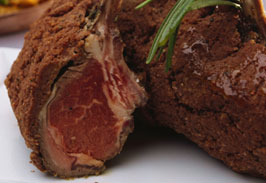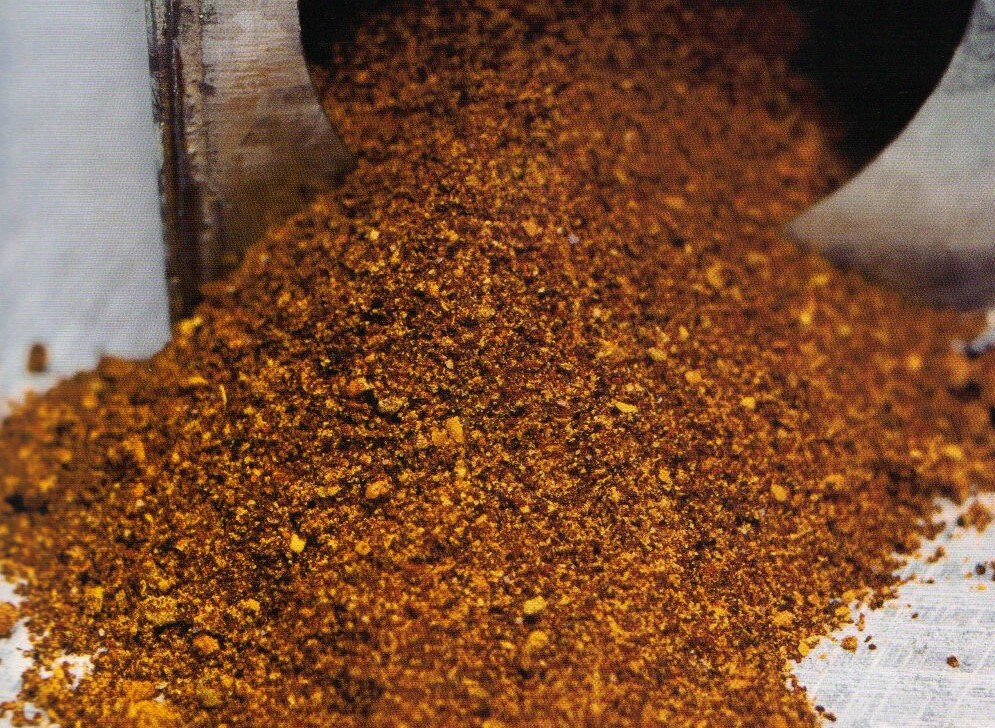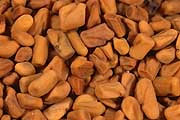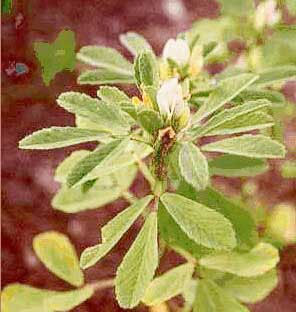Recipe for October 2008
 Berbere-Crusted Rack of Lamb
Berbere-Crusted Rack of Lamb
6-8 servings
Ingredients
½ cup olive oil
1½ tablespoons coarsely chopped rosemary
1 large garlic clove, smashed
3 tablespoons Berbere (below), divided
2 teaspoons Dijon mustard
2 teaspoons beaten egg yolk
¼ cup fine bread crumbs
2 to 3 tablespoons dry red wine, divided
½ cup chicken stock
2 tablespoons cold unsalted butter, cut into pieces
Method
Combine the oil, rosemary and garlic in a large zipper-lock bag. Add the lamb, then seal the bag, forcing out the excess air. Marinate in the refrigerator for 8 to 24 hours, turning several times. Preheat the oven to 400 degrees F.
The Bebere Paste:
Stir together 1 tablespoon of the berbere, the mustard, yolk and bread crumbs in a small bowl, then add 1 to 2 tablespoons of the wine, just enough to make a paste. Refrigerate until ready to use.
Remove the lamb from the marinade and pat dry; discard the marinade. Heat a dry, large heavy saute pan over high heat, until very hot. Reduce the heat to medium-high and brown the lamb, one rack at a time, about 3 minutes per side. Transfer, fat side up to a large roasting pan.
Smear the berbere paste on the fat side of the lamb. Roast until an instant-read thermometer inserted into the center of the rack reads 125 degrees, for medium-rare, about 18 to 20 minutes. Transfer the lamb to a cutting board and let rest for 10 minutes.
While the lamb is roasting, toast the remaining two tablespoons berbere in a very heavy saucepan over low heat, stirring constantly, until very fragrant, about a minute. Add the chicken stock, 1 tablespoon wine and bring to a boil, then boil until reduced to the consistancy of a sauce. Remove from the heat and whisk in the butter bit by bit until incorporated.

From the cookbook "The Soul Of A New Cuisine," A Discovery Of The Foods and Flavors Of Africa, by Marcus Samuelsson.
"In Ethiopia, the preparation of Berbere takes days-chilies are dried in the sun for three days, then ground in a mortar and pestle, mixed with ground spices, and set in the sun to dry again- and it is usually made in huge amounts, using as many as fifteen pounds of chilies and five pounds of garlic. Each Ethiopian family has its own recipe for this universal seasoning, with varying degrees of heat and spiciness. Traditionally, berbere is used to flavor Ethiopian stews, but I also like to use it as a rub for beef and lamb."
 Berbere
Berbere
Ingredients
Makes 1 cup
1 teaspoon fenugreek seeds*
½ cup ground dried serrano chilies or other ground chilies
½ cup paprika 2 tablespoons salt
2 tablespoons ground ginger 2 teaspoons onion powder
1 teaspoon ground cardamom, preferably fresh ground
1 teaspoon ground nutmeg ½ teaspoon garlic powder
¼ teaspoon ground cloves ¼ teaspoon ground cinnamon
¼ teaspoon ground allspice
Method
Finely grind fenugreek seeds with a mortar and pestle or in an electric spice or coffee grinder. Stir together with the remaining ingredients in a small bowl until well combined.Seal in an airtight container in the refrigerator for up to 3 months.
~
 *The name fenugreek or foenum-graecum is from Latin for "Greek hay". The plant's similarity to wild clover has likely spawned its Swedish name, "bockhornsklöver", literally meaning 'ram's horn clover'. Zohary and Hopf note that it is not yet certain which wild strain of the genus Trigonella gave rise to the domesticated fenugreek but believe it was brought into
*The name fenugreek or foenum-graecum is from Latin for "Greek hay". The plant's similarity to wild clover has likely spawned its Swedish name, "bockhornsklöver", literally meaning 'ram's horn clover'. Zohary and Hopf note that it is not yet certain which wild strain of the genus Trigonella gave rise to the domesticated fenugreek but believe it was brought into  cultivation in the Near East. The word for fenugreek in Amharic is abesh, and the seed is reportedly also often used in Ethiopia as a natural herbal medicine in the treatment of diabetes.
cultivation in the Near East. The word for fenugreek in Amharic is abesh, and the seed is reportedly also often used in Ethiopia as a natural herbal medicine in the treatment of diabetes.
In Egypt, fenugreek seeds are prepared as tea, by being boiled then sweetened. This is a popular winter drink served in coffee shops. In other parts of the Middle East fenugreek is used in a variety of sweet confections. A cake dessert known as Helba in the Islamic world is a tasty treat during Islamic holidays. This is a semolina cake covered in sugar or maple-like syrup, and sprinkled with fenugreek seeds on top.


